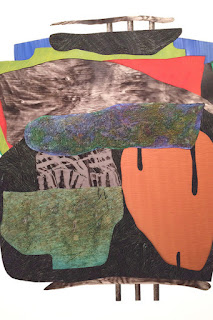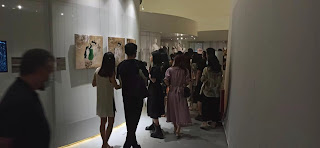{{{Please click on the images to enlarge them.}}}
In the 1960s Lenny Bruce once joked: “If Jesus had been killed twenty years ago, Catholic school children would be wearing little electric chairs around their necks instead of crosses.” So, what was going through the heads of some design firm when they chose, basically, a cruciform structure for the common American execution gurney? Was this a tip of the hat to Lenny Bruce? If America executes any messiahs in the near future, we already have the religious jewelry?
Maybe everyone in contemporary America should wear a small execution gurney around his/her neck anyway. This seems, indeed, our American god, the god of deterrence. Whether he is effective or not, he is the god we turn to the most in our social-management operations. The god is served by a corrupt priesthood, involving systemic racism in our police departments.
Jackie Black’s photography show Last Meal, at the Parrish Art Museum, compels all of us to look at some victims of our prison-industrial complex (many of whom professed their innocence to the end) through their last meals on death row.
Retribution as an act of deterrence is probably the most used and least questioned emotional response in our society. Even severely mentally ill people, people who suffer from schizophrenia, are routinely punished in our legal system as if they were “responsible” for their actions.
This is due to a basic fear that if we allow someone to get away with a crime, this will give license to others to commit the same crime. To revisit a story Foucault told, it did not matter to the 18th century French that Robert Damiens was severely mentally ill; he had tried to kill the king, so he had to be hanged, drawn and quartered.
Damiens had to be tortured to death as a deterrent to anyone who might consider regicide in the future, even though only severely deranged folks oblivious to the force of deterrence probably considered such foolhardy assassinations.
Retribution as a form of deterrence is like a fixed action pattern in humanity. The male red-bellied stickleback fish will attack anything red during mating season whether it makes sense to attack it or not (sometimes they attack red-colored stones), and any time there is an act of harm, we have to attack someone, because nature blindly stuck this fixed action pattern into us for some basic survival value, regardless of how wasteful and ineffective it might be in truly eliminating harmful behavior.
We do not show high ethical values when we do this. We act like a bellicose fish in mating season.
Do we take action to help children who live in violent and economically deprived neighborhoods so that they will not be molded into future criminals? No. We do not worship that God in our society, we worship the prison-building, capital punishment god six days a week.
On Sunday we pay lip service to the real God. 65% of white, mainline Protestants support capital punishment as do 59% of white Catholics. 33% of Black Protestants support the death penalty while 37% of Latinos support it.
The meals themselves of these 23 individuals from Texas’ Death Row are revealing. Fast food seems to predominate in the choice for a last meal judging from this show. The prisoners are told they may order anything they want, and it seems often to be some type of fast food dish.
The years of formal education that each prisoner completed is also provided along with a photo of what his last meal might have looked like. It seems, perhaps, that lacking an extensive formal education, and the experience this opens for people, the prisoners are not even aware of the multitude of food choices that are available.
Like most folks who are born into and grow up in poverty, they seem to gravitate toward the cheapest, unhealthiest, most toxic food.
There are exceptions. One prisoner requested that his final meal go to a homeless person (this request was denied). Another requested “Justice, Equality and World Peace”. A man who professed his innocence ordered a purely vegetarian meal. His last meal was, therefore, putatively based on his ethical principles – evincing proof that he was not a killer of people any more so than of animals.
Or, perhaps, he had changed in prison, or, if he had committed the murder, this last meal might have been a final ruse to demonstrate a false innocence. Who knows. These folks are usually poor and, as studies show, one is more likely to go to jail if he/she has to use a public defender, and more likely to receive a more severe sentence.
So, it becomes difficult to tell who really was “guilty” and who was not. 20 individuals have been exonerated by DNA evidence while on Death Row. It is, in fact, chilling to think of how many innocent people might be in prison.
Few of the prisoners referenced in this show had much of a formal education. Many did not seem to even make it to high school. Statistics show that as of 2016 about 49% of prisoners on death row had not graduated high school. 44% had a high school diploma or GED. 9% had some college.
This would seem to indicate that if we were really serious about eliminating crime in the USA, we would focus more on helping children get into and stay in school in lieu of the building of more and more prisons. California spends about $65,000 per year on the average prisoner and $12,000 per year on the average student. New York spends $70,000 per prisoner as opposed to $22,000 per student. We worship the god of deterrence and not the God of Mercy and Justice.
You have probably read Shirley Jackson’s short story The Lottery. At the end, it is only the victim of a senseless ritual who realizes how evil and unjust the ritual is. Everybody else believes in it. The statements made by prisoners about to be executed also show that these men are fully aware that something wrong is occurring, even if they do admit their guilt, even if everyone else is convinced that capital punishment is right.
Robert Madden said, "I apologize for your loss and your pain. But I didn't kill those people. Hopefully, we will all learn something about ourselves and each other. And we will learn to stop the cycle of hate and vengeance and come to value what is really going on in this world”.
Thomas Andy Barefoot said, "I've been praying all day for (the victim's) wife to drive the bitterness from her heart because that bitterness that's in her heart will send her to hell just as surely as any other sin. I'm sorry for everything I've ever done to anybody. I hope they'll forgive me." The defiance in Johnny Garret’s statement, a man who had 7 years of formal education, speaks volumes: "I'd like to thank my family for loving me and taking care of me. And the rest of the world can kiss my ass."
David Wayne Stoker said, “I am truly sorry for your loss…but I didn’t kill anyone.”


























































